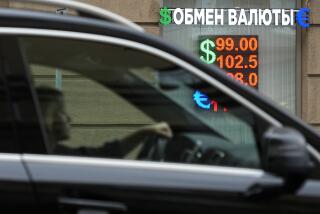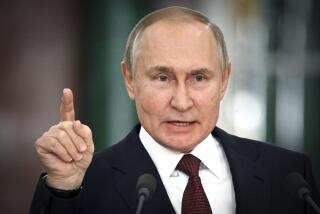Ruble ‘in Free Fall’ After Central Bank Halts Dollar Trades
- Share via
MOSCOW — Russia’s fiscal crisis deepened Wednesday as the ruble plunged to new lows, falling 40% in value against the German mark after the Central Bank took the drastic step of temporarily halting major trades of rubles for dollars.
As Russians lined up at banks across the country in the hope of withdrawing their savings from the nation’s teetering financial institutions, acting Prime Minister Viktor S. Chernomyrdin abruptly flew to Crimea for high-level meetings aimed at slowing the spread of the crisis to other former Soviet republics.
Russia’s Central Bank, which has spent billions of dollars in recent months to prop up the ruble, appeared powerless to halt its slide over the long term but annulled millions of dollars worth of currency exchanges in a last-ditch effort to save the nation’s currency.
Economists said the move would only briefly delay the inevitable fall of the ruble to a level reflecting its true value. Some predicted that the ruble--which fell to 8.26 to the dollar although it had officially been set at 7.86--could quickly plummet to as low as 20 to the dollar.
“It’s a currency in free fall,” said Rory MacFarquhar, an economic analyst with the Russian European Center for Economic Policy.
Although Russians have weathered worse economic crises in the past, the fall of the ruble has highlighted widespread corruption in the banking sector and dashed any remaining hopes that the economy could right itself before 2000.
The fall of the ruble instantly makes the Russian people poorer by sending the prices of imported goods soaring, depleting savings and stoking inflation, although it also could stimulate the growth of Russia’s export industries. At the same time, it drastically undermines international confidence in Russia and drives out the foreign investment that the country so badly needs to achieve some stability as it seeks to reform the economy.
While most Russians keep their savings in dollars under their mattresses, those with bank accounts lined up at branches in the hope of extracting some of their savings before a widely anticipated bank collapse.
In Moscow, many banks limited withdrawals to $500 or $1,000 a day for each account. Some refused to return dollar deposits and offered customers their money back only in rapidly devaluing rubles. Some banks refunded money at a snail’s pace, handling fewer than 100 customers despite daylong crowds outside their doors. Many depositors went home disappointed, frustrated and angry.
Vera Maslova, a 76-year-old widow, spent seven hours outside a Moscow branch of Inkombank in an unsuccessful bid withdraw $2,000 she deposited six months ago at the promise of 15% interest.
“I was saving this money for my funeral,” said Maslova, who lost her lifetime savings once before during a currency “reform” of the early 1990s. “How stupid I was to trust my money to them. Why is it that all my life I get nothing good? Why is it that I am always cheated and treated like dirt?”
While many banks balked at returning money to their depositors, a number of bankers appeared to have sufficient rubles for currency speculation, snapping up German marks and French francs to protect their assets after the Central Bank blocked trades for dollars.
Some economists placed much of the blame for the crisis on greedy bankers who have steadily drained Russia of its wealth by engaging in currency speculation and shipping their profits to bank accounts outside the country.
Billions of dollars spent by the government to support the ruble--including money lent to Russia by the International Monetary Fund, or IMF--have ended up in the hands of bankers and currency traders, who have made a killing in recent months by buying dollars cheaply and sending them abroad.
“The banks are taking advantage of the awful economic policies of the government,” said Roland Nash, chief economist for MFK Renaissance, an investment bank. “People are not able to get their money out of banks. At the same time, the banks are using rubles to buy dollars.”
MacFarquhar, the economic analyst, went even further. He charged that Central Bank officials had propped up the ruble as long as possible to give their friends in private banks a chance to milk everything they could from the motherland.
“You gain nothing by delaying devaluation except the chance to steal more and take more out of the country,” said the disgusted economist. “They wanted to give their friends a little more time to take their goods to Switzerland.”
After spending $8.8 billion in the past two months to support the ruble, the Central Bank has finally acknowledged that it no longer can afford to prevent devaluation with cash infusions.
The ruble fell 10% in value against the dollar Tuesday and quickly dropped another 5% Wednesday morning before the Central Bank stepped in and canceled the day’s transactions.
The ruble was trading last week at 6.2 to the dollar.
This summer, the IMF sought to restore the confidence of foreign investors in Russia’s economy by helping put together a $22.6-billion bailout package. But the promise of loans came too late to prevent disaster.
Chernomyrdin, in the midst of putting together a fiscal rescue plan and trying to win quick confirmation from parliament as prime minister, broke away Wednesday evening to jet to Crimea in southern Ukraine and meet with IMF Director Michel Camdessus. Officials did not divulge what was discussed, but the IMF head presumably expressed his disappointment in Russia’s failure to live up to its promises under the loan pact, such as a vow to improve tax collection.
Sergei L. Loiko and Alexei Kuznetsov of The Times’ Moscow Bureau contributed to this report.
(BEGIN TEXT OF INFOBOX / INFOGRAPHIC)
Currency Crumbles
Russia’s financial crisis grew Wednesday as the ruble sank even lower and the Central Bank canceled dollar sales. Economists said the move would only briefly stem the ruble’s fall.
Russian rubles to U.S. dollar
Jan. 2: 5.95
Aug. 26: 8.26
Sources: Bloomberg L.P., Associated Press
More to Read
Sign up for Essential California
The most important California stories and recommendations in your inbox every morning.
You may occasionally receive promotional content from the Los Angeles Times.










